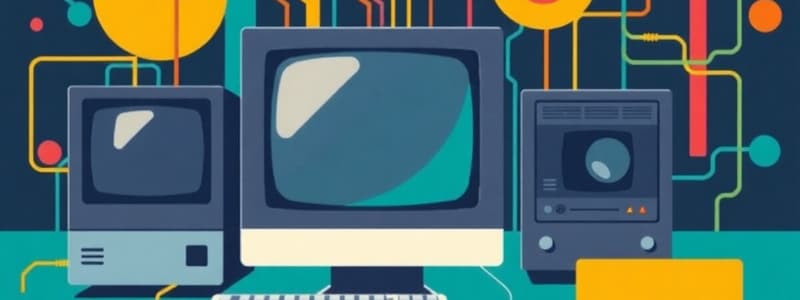Podcast
Questions and Answers
Which of the following best describes the evolution of computers?
Which of the following best describes the evolution of computers?
- A progression driven by the human desire to quantify, compute, and retain data (correct)
- A decline in computational capabilities due to miniaturization.
- A steady increase in size and power, with no significant changes in functionality.
- A shift from specialized devices to general-purpose machines.
What was the primary function of Napier's Bones, invented by John Napier?
What was the primary function of Napier's Bones, invented by John Napier?
- Tabulating data for census purposes.
- Performing complex algebraic equations.
- Creating the first automated loom.
- Aiding in mechanical multiplication, division, and extraction of square roots. (correct)
How did Gottfried Leibniz build upon Blaise Pascal's invention?
How did Gottfried Leibniz build upon Blaise Pascal's invention?
- By designing a smaller, more portable version of Pascal's calculator.
- By creating the first general-purpose computer.
- By developing a machine capable of performing all four basic arithmetic operations and extracting roots. (correct)
- By integrating punched cards for automated calculations.
What key concept introduced by Joseph Marie Jacquard influenced the development of computers?
What key concept introduced by Joseph Marie Jacquard influenced the development of computers?
What distinguishes Babbage's Analytical Engine from his Difference Engine?
What distinguishes Babbage's Analytical Engine from his Difference Engine?
What contribution did Frank Stephen Baldwin make to the field of computing?
What contribution did Frank Stephen Baldwin make to the field of computing?
How did Herman Hollerith's work contribute to the automation of data processing?
How did Herman Hollerith's work contribute to the automation of data processing?
What is the significance of Stonehenge in the history of computing?
What is the significance of Stonehenge in the history of computing?
Why is the Jacquard loom considered a forerunner of modern-day automation?
Why is the Jacquard loom considered a forerunner of modern-day automation?
Which invention directly enabled Herman Hollerith to automate the 1890 U.S. Census?
Which invention directly enabled Herman Hollerith to automate the 1890 U.S. Census?
Flashcards
Napier's Rods/Bones
Napier's Rods/Bones
Used to mechanically multiply, divide, and find square roots
Pascal's Machine
Pascal's Machine
Pascal's Arithmetic Machine performs addition, subtraction, counting; has numbered wheels
Liebnez's Machine
Liebnez's Machine
Modified Pascal's ideas into a gear-driven machine that added, subtracted, multiplied, divided, and extracted roots.
Jacquard's Loom
Jacquard's Loom
Signup and view all the flashcards
Babbage's Difference Engine
Babbage's Difference Engine
Signup and view all the flashcards
Babbage's Analytical Engine
Babbage's Analytical Engine
Signup and view all the flashcards
Frank Stephen Baldwin
Frank Stephen Baldwin
Signup and view all the flashcards
Herman Hollerith's Machine
Herman Hollerith's Machine
Signup and view all the flashcards
Study Notes
- Computers have evolved because humans want to count, compute, and store data.
- Today's computers are very different from earlier models.
- The size of computers has greatly decreased since the 1970s and 1980s because of new technology.
- The history of computers includes hardware growth, events, and innovations since the Stone Age.
A Summary of Computing History
- 1500 B.C.:
- Greece used boxes or sand trays to hold pebbles when counting.
- The Orient used strung beads for counting; this was the beginning of the abacus.
- England used Stonehenge as giant astronomical computer.
- 1617: John Napier created Napier's rods or bones, which could mechanically multiply, divide, and take square roots; he published the world of logarithms in 1641.
- 1642: Blaise Pascal invented Pascal's Arithmetic machine, which had 10 numbered wheels and a series of gears, similar to today's adding machines; it could count, add, and subtract with a turning crank.
- 1673: Gottfried Leibniz modified Pascal's concepts to create a gear-driven machine that could add, subtract, multiply, divide numbers, and extract roots.
- 1804: Joseph Marie Jacquard introduced the automatic loom (Jacquard's Loom), which used metal plates with punched holes to control the weaving pattern. This was a precursor to modern day automation.
- 1812-1834: Charles Babbage began working on his two machines in 1812, including the difference machine and the analytical machine.
- Babbage's Difference Engine was supposed to be used to make ballistic tables.
- George Scheutz built it, even though Babbage never finished it.
- Twenty-first century computers all had parts of Babbage's design.
- 1834-1871: Babbage's Analytical Engine was designed to be the very first general-purpose computer, but it was never constructed in Babbage's lifetime.
- 1875: Frank Stephen Baldwin received the first U.S. patent for a calculating machine that could perform the four basic arithmetic operations.
- 1885-1896: Herman Hollerith created a code and a set of tools for punching data into cards and tabulating it
- This was used to automate the 1890 U.S. Census.
Studying That Suits You
Use AI to generate personalized quizzes and flashcards to suit your learning preferences.




